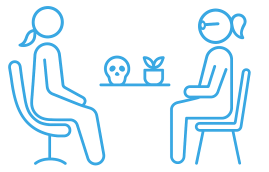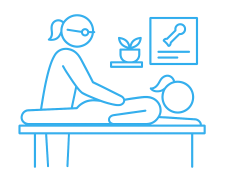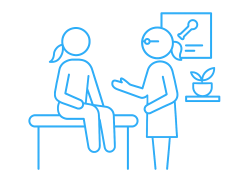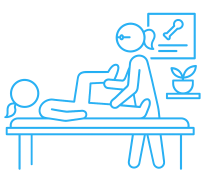Osteopathy
Welcome to our Osteopathy page. Here you will find more information on Osteopathy and how it could help you.
What is Osteopathy?
Osteopathy is the recognised and established science of human mechanics; a system of diagnosis and treatment which lays the main emphasis on the structural and mechanical problems of the body. Osteopathy is a hands-on therapy and Osteopaths use a range of highly skilled techniques to treat the patient.
Osteopathy at Northallerton Osteopaths
We believe in a holistic approach to healing. Here at Northallerton Osteopaths our practitioners treat the person as a whole in order to find the cause of a condition, rather than treating only the symptoms.
In 2023 we made it as finalists of the prestigious (Institute of Osteopathy) UK Practice of the year 2023. We followed this up in 2024 by going one better and winning the award, crowning us UK Practice of the Year 2024. The UK practice of the year award celebrates practices who provide outstanding care and customer service to their community. This remarkable achievement recognises our commitment to excellence in patient care and marks an exciting milestone in our journey of providing outstanding osteopathic services
Our Osteopaths are highly skilled in their sense of touch (palpation) and they use these skills to observe imbalances and dysfunction in the joints and soft tissue structures of the musculo-skeletal system (muscles, ligaments, capsules, fascia and tendons). Once the inter-relationship of these neighbouring structures is understood, they use a range of highly skilled techniques to treat the patient.
Treatments vary from patient to patient but may include:
- Soft tissue massage
- Joint articulation with varying degrees of subtlety
- Rhythmic stretching
- Joint manipulation
- High-Velocity-Thrust manipulation (HVT)
- Muscle Energy Technique (MET)
- Exercise prescription
If you are unsure if we could help you, please contact us and request a call back from one of our practitioners.
"I would highly recommend this practice, which is easy to locate, clean and modern. My osteopath here really makes you feel at ease during treatment, he is very professional and sympathetic and quickly restored movement to my locked and spasming back. He has gone out of his way to squeeze me in for an emergency appointment when I’ve been in agony with my back. The receptionists are really lovely and it’s pretty easy to get an appointment. Worth every single penny"
Mrs L Mapp, Northallerton
What Can It Help
Back Ache
Back Pain
Sciatica
Arthritic Pain
Muscle Spasm
Muscle tension and inability to relax
Joint Pain
Shoulder Pain
Headaches arising from the neck (cervicogenic)
Migraine prevention
Hip Pain and Knee Pain from Osteoarthritis
Elbow Pain
Tennis/Golfer's Elbow
Frozen Shoulder
Generalised Aches and Pains
Lumbago
Neuralgia
Fibromyalgia
Digestive problems
Circulatory problems
Rheumatic Pain
Cramp
To Aid Relaxation
Above all else, Osteopaths treat the person not the condition. And although Osteopaths are best known for it, we don't just treat backs!
During a consultation and examination, all areas of symptoms are taken into account, and the osteopath works with structural imbalances that are present in the body to restore a state of physical balance. Patients often report improvement in many areas of their health, not just the symptomatic area.
What to Expect
Consultation

Your Osteopath will take a comprehensive case history, covering your current area of concern as well as a full medical history.
Examination

Relevant observations of posture and movement patterns will then take place, and may observe clinical and orthopaedic tests to ascertain a diagnosis.
Treatment

If appropriate, treatment will then take place and may include techniques such as soft tissue massage, joint articulation & mobilisation, stretching, joint manipulation and exercise prescription. Where treatment is not appropriate your Osteopath will discuss your options with you, in some cases it may involve referral to your GP or an alternative practitioner.
Treatment Plan

Very few issues resolve in 1 session. In a recent audit of the clinic over 60% of our patients have their problem resolved within 3 visits, and 90% within 6 treatments.
Long Term

If you are suffering from a long term problem it may take longer to notice an improvement or for the issue to fully resolve.
Maintenance

Additionally, more people are recognising that certain conditions need ongoing care and they elect to attend for regular maintenance treatments to keep on top of symptoms, attending anywhere between once per month and once per year.
We have signed up to the Institute of Osteopathy Patient Charter which demonstrates our commitment to high standards of patient care. You can view the Charter here.
"I have been using Northallerton Osteopaths for several months. The clinic is well situated with parking available on site. I am very impressed by the service received from the receptionist to the Osteopath. The treatment received to my neck and lower back have made a great difference, which is down to the expertise of Ross the Osteopath who is treating me"
Mr P Leng, Northallerton
More on Osteopathy
Patients
Osteopaths are trained in therapeutic approaches that are suitable for a broad range of individuals of all ages, including pregnant women, children & babies, sports people and the elderly.
Training
Osteopathy is a fully regulated medical profession and the title Osteopath is protected by law. Osteopaths undertake 4-5 years of university training at specialist colleges and are regulated by the General Osteopathic Council.
Intervention
Osteopathic care is delivered through a range of interventions which may include health management advice, manual therapy, exercise therapy, onward referral and others.
Technique
Osteopaths adapt their therapeutic approach depending on the individual needs of the patient and their presenting complaint. Manual therapy techniques employed may include articulation and manipulation of joints and soft tissues.
Regulation
Osteopaths have been regulated by statute since 1993 by the General Osteopathic Council (GOsC) and may refer to conditions for which medical supervision should be sought if they hold convincing evidence of the efficacy of their treatments.
Referral
The British Medical Association guidance for GPs states that doctors can safely refer patients to osteopaths. Although Osteopathy is not offered widely on the NHS under its current framework. Osteopaths are trained to screen for medical conditions and will tell you if you need to see another health professional such as your doctor or midwife.
"Was recommended by a friend, I received excellent treatment. Would definitely recommend them and will not hesitate to go back again if needed."
Lisa Bradley
Osteopath vs Chiropractor - What's the Difference?
We are often asked what is the difference between an osteopath and chiropractor. To tell the truth, we have more similarities than differences.
Similarities
Both professions :
- Focus on the diagnosis, treatment and prevention of disorders within the musculoskeletal system.
- Use hands-on manual therapy to treat the patient
- Are specially trained to deliver thrust manipulations to the spine, which may produce an audible ‘click’.
- Give exercise and posture advice to further promote their patient’s recovery
- Require a minimum 4 years university training
What differs is the philosophy of Osteopathy and Chiropractic.
Differences
What they treat :
An Osteopath will take a more holistic approach and view the body as a whole, and believes that all bones, ligaments, muscles and connective tissues must work harmoniously together. A Chiropractor would mostly be concerned with treating the spine, but may treat the shoulders, hips and knees.
How they assess :
A Osteopath is trained to develop a highly sensitive sense of touch (palpation), and uses their hands to observe the structure and function of problem areas.
A Chiropractor often uses diagnostic equipment such as X-Ray and MRI scans to determine the position of the spine and it’s joints.
An Osteopath is concerned with how joints and their neighbouring structures move, whereas a Chiropractor may be more concerned with their position and 'alignment'.
How they treat :
An Osteopath will use a wider variety of techniques. As well as the spinal manipulations, they also utilise more gentle ‘indirect’ techniques such as functional, positional release and cranial techniques to observe subtle strains throughout the body and address them accordingly. They also frequently use soft tissue massage and stretching techniques.
Some Chiropractors may work on the muscles, however they are primarily concerned with manipulating the spine, known as ‘adjustments’.
A Chiropractor may also use a small hand-held tool to treat back and neck pain. The Activator Method involves using a small spring-loaded instrument called an Activator Adjusting Instrument that delivers a single thrust at the determined site to correct a malfunctioning joint.
Treatment length and frequency :
An Osteopath treatment is usually 30-45mins.
A Chiropractor session tends to be shorter at 15-20mins and mostly involves 'adjustments'.
Osteopath treatments tend to be around one a week initially, and as the condition improves the patient will attend less and less frequently dependent on their individual needs and pay as they go.
Chiropractic sessions are sometimes sold as courses, in the example of 10 sessions being required, they are sold as a block and the patient may visit 2-3 times per week for several weeks.
To conclude, the philosophy of both Osteopathy and Chiropractic are open to interpretation to the individual practitioner, there are many Osteopaths practising like Chiropractors, just as there are many Chiropractors practising like Osteopaths. No one profession is better than the other, both are highly skilled practitioners when it comes to dealing with problems areas in the musculoskeletal system and you should expect an excellent service from either professional.
Summary
Osteopathy
- Primarily treats the musculoskeletal system (MSK) of the body and injuries/conditions arising from here
- Some Osteopaths may treat respiratory and digestive ailments
- Has a wide array of techniques, including but not exclusive to soft tissue massage, joint articulations, spinal manipulations (clicks)
- A primary complementary or alternative medicine (CAM) not usually offered on the NHS
- Hands-on therapy to detect, treat and prevent dysfunction of the bones, muscles, ligaments and joints of the MSK
- Views the body as a unit and as a whole. Treats neighbouring joints and structures
- Holistic approach and treats all joints and areas of the body, looking for the cause of an issue
- Go by what they feel through palpation
- Requires 4-5 years university degree training
- Registered with the General Osteopathic Council (GOsC) and have their title as an Osteopath protected by law
- Cranial techniques are used by some osteopaths, where they can detect extremely subtle strains throughout the body
Chiropractic
- Deals primarily with spinal manipulation, known as ‘adjustments’
- Most chiropractors do less work through the muscles and other soft tissue structures of the MSK
- Treatment works primarily with the spine, however can be used to treat the shoulders, hips and knees
- Chiropractors believe if the structure of the spine is healthy, then the nervous system is healthy
- A primary complementary or alternative medicine (CAM) not usually offered on the NHS
- Often tools are used such as the Activator Method
- Requires 4 years university degree training
- Registered with the General Chiropractic Council (GCC) and have their title as a Chiropractor protected by law
Osteopath vs Physio - What's the Difference?
Osteopathy and Physiotherapy have plenty of similarities. They both aim to improve the physical health and quality of life for the patients that they see.
However, what can differ is the way that they go about this and the type of patients that they may see. Whilst there is some crossover and certain conditions can be successfully treated by either professional, it is important you understand the difference between the two as your condition may be better suited to one profession over the other.
Lets have a look at how they differ.
Job Role
Osteopaths are specialists when it comes to dealing with the Musculoskeletal (MSK) system. This means they often see people who are experiencing pain or injury such as; back pain, neck pain, hip pain, sports injuries and muscular spasm. Some Osteopaths also deal with digestive and respiratory ailments.
Physiotherapists can work with injuries of the MSK too, but they also focus on conditions arising from other systems of the body (Neurological, Cardiovascular and Respiratory). This means that they commonly deal with conditions such as MS, Parkinson’s disease and COPD, or help patients as they recover from a Stroke or Heart attack.
How they work
Osteopaths are trained to develop a highly sensitive sense of touch and use ‘palpation’ to diagnose and treat their patients. This makes Osteopathy a very hands-on profession and they use techniques such as soft tissue massage, joint mobilisation and spinal manipulation to improve the structural and mechanical problems of the body. To complement this, an Osteopath will prescribe home exercises to the patient if they deem it necessary.
Whilst Physiotherapists do use hands-on techniques, it is less so in comparison to Osteopaths. Physiotherapists will use a wider range of techniques that do not require any hands-on involvement such as exercise prescription, ultrasound, hydrotherapy and electrotherapy to name a few. Physiotherapy is also known as ‘Physical Therapy’, and as a result exercise prescription is often at the core of a patient’s rehabilitation. This means that the patient is encouraged to participate in physical exercise as part of the treatment process.
The philosophy of Osteopathy is that the body is a unit and should be treated as a whole. This means it is common for Osteopaths to treat neighbouring joints and structures if they feel it is relevant to do so. As a result they look for the cause of an issue rather than only treating where the pain is.
For the MSK system, Physiotherapists commonly monitor specific muscle groups and parts of the body rather than the whole body.
Qualifications
Both Osteopaths and Physiotherapists are highly skilled and trained in their own rights, and you should expect an excellent service from whomever you see.
To be an Osteopath you need to have an accredited Osteopathy degree, which usually lasts 4-5 years and also be registered with the General Osteopathic Council (GOsC) by law.
To be a Physiotherapist you need to have an accredited Physiotherapy degree and be registered with the Health and Care Professions Council (HCPC) by law. A Physiotherapy degree usually lasts 3 years, however you can take a 2 year postgraduate Physiotherapy degree if you already obtain a degree in a relevant subject such as; Sports Science, Psychology or Biological Science.
Summary
Osteopathy
- Primarily treats the musculoskeletal system (MSK) of the body and injuries/conditions arising from there
- Some Osteopaths may treat respiratory and digestive ailments
- Primarily a hands-on therapy to detect, treat and prevent dysfunction of the bones, muscles, ligaments and joints of the MSK
- Has a wide array of techniques, including but not exclusive to soft tissue massage, joint articulations, spinal manipulations (clicks)
- Views the body as a unit and as a whole. Treats neighbouring joints and structures
- Holistic approach and treats all joints and areas of the body, looking for the cause of an issue
- Trained in diagnosis
- Trained to develop a highly sensitive sense of touch (palpation)
- A primary complementary or alternative medicine (CAM) not usually offered on the NHS
- Requires 4-5 years university degree or masters training in Osteopathy
- Registered with the General Osteopathic Council (GOsC) and have their title as an Osteopath protected by law
Physiotherapy
- Offers rehabilitation to all the major systems of the body, including Neurological, Musculoskeletal, Respiratory and Cardiovascular
- Is the physical approach to promote, maintain and restore physical health
- Primarily involves patient participation in their rehabilitation via physical exercise
- A means of restoring balance, independence and strength after severe trauma, injuries and operations
- Other techniques such as manual therapy may be used
- A course of physiotherapy is typically tailored to the area of the body where the symptoms are
- Physiotherapy is freely available on NHS
- Requires 3 years university degree training in Physiotherapy
- Some Physiotherapists can do a 2 year postgraduate Physiotherapy degree if they have an undergraduate in a relevant subject (i.e Sports Science, Psychology)
- Registered with the Health and Care Professionals Council (HCPC)
